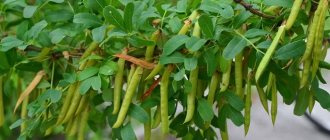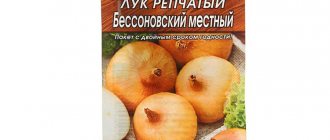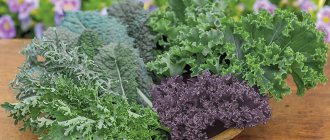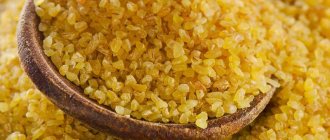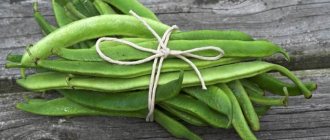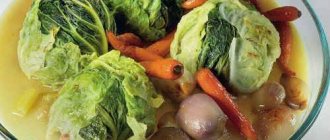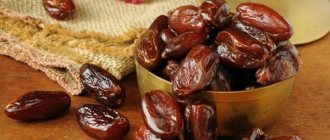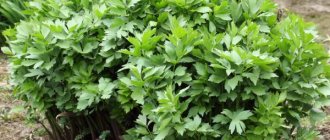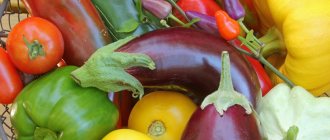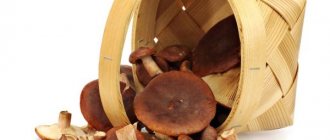Useful properties and contraindications of the plant
What is so attractive about mountain onions, besides the decorative inflorescences? A number of experts believe that the plant’s medicinal properties are close to the famous ginseng; it is not without reason that it is widely used in folk medicine and pharmacology.
Bulbs and leaves contain:
- carotenoids;
- vitamins C, D, E;
- saponins;
- phytoncides;
- mineral salts.
On a note! In terms of vitamin C content, Suvorovsky is superior to onions.
Recommended for increasing the body's defenses, improving brain function, memory, and activating metabolic processes. Thanks to the beneficial substances contained in the onions, the aging of the body slows down, and relief from a number of problems is observed: senile tremor, deterioration of vision and hearing, dizziness. Of course, anzur onion is not a panacea for diseases, but it is effective as a general tonic.
In folk medicine it is used to treat various diseases:
- migraine;
- epilepsy;
- acute respiratory infections;
- sinusitis.
The juice of fresh onions and green leaves is indicated for digestive disorders, bladder problems, and joint diseases. It is also recommended to use a tincture of the plant’s leaves to strengthen hair and improve the condition of the skin.
The ability of mountain onions to protect the human body from dangerous and insidious scurvy has long been known. According to legend, thanks to this plant the famous Russian commander A.V. Suvorov saved his army from scurvy during a difficult crossing of the Alps. The variety owes its name to this historical episode.
The high content of biologically active components in greens and bulbs is both an advantage and partly a disadvantage. This plant should be used as food and as a medicine carefully and carefully, keeping in mind possible allergic reactions and side effects.
Raw onions must be subjected to heat treatment, as they contain special substances that can harm the human body.
Description of the variety
From the point of view of biological classification, this is a plant of the Onion genus, which is part of the Onion subfamily of the Amaryllidaceae family. Latin name: Allium suworowii.
Often Suvorov's onion and several closely related (and therefore easily hybridized with it) varieties are called the collective term "Anzur", which translated from the Tajik language means "mountain onion".
Origin and development
Anzur is a wild onion that is found naturally in the Tien Shan mountains and surrounding areas. Suvorov's onion is endemic to the Western Tien Shan. Hybrids, often grown in flower beds and vegetable gardens, also come from other onions that grow in mountainous areas.
Anzur is a perennial bulbous plant. Its mountain origin left its mark on its biological characteristics: accelerated germination with a long dormant period.
Suvorov's bow is often confused with Aflatun and Dutch. They are similar and come from approximately the same places. But the difference between them is significant: Aflatun and Dutch onions are often grown only as ornamental plants, and Suvorov onion-garlic is a food and medicinal crop, although it also blooms beautifully.
Numerous varieties of Anzurov often have such an intricate pedigree that only DNA analysis can determine which species of mountain wild onions they originated from. There are often resistant hybrids that do not have Mendelian splitting in the second generation (that is, their seeds are suitable for further cultivation of the vegetable).
Chemical composition, trace elements and vitamins
Suvorov's onion is extremely rich in vitamins. It contains 5 times more vitamin C than onions. It also contains a lot of vitamins B, E and mineral salts.
The exact composition depends on the growing conditions and soil: like all onions, Anzur accumulates substances from the soil.
Beneficial properties for the human body
Anzur has long been used in folk medicine in Central Asia . It is believed that with regular use of mountain onions, vision becomes sharper, headaches go away, and hand tremors decrease.
When Anzur is included in the diet, nonspecific immunity is strengthened and the functioning of the cardiovascular system is improved. This onion is used to treat vitamin deficiency.
Harm and contraindications for use
The wealth of essential oils and biologically active substances that make Suvorov's onion useful in folk medicine also has a downside: this onion is a strong allergen. A considerable number of people have a congenital intolerance to Anzur.
The sharpness of mountain onions can adversely affect the course of gastrointestinal diseases. In particular, with ulcers or erosion of the walls of the stomach or intestines, it is absolutely contraindicated.
Important! Only the young leaves of onion-garlic are eaten raw. Eating an onion that has not been boiled, pickled or baked is undesirable even for healthy people: the concentration of essential oils is so high that there is a risk of poisoning.
Ripening period
Suvorov's onion grows slowly. In the first year after forcing the cotyledons, the plant goes into a dormant state and forms small bulbs only before winter. In the second year, the bulbs increase in size, but do not split yet. And only in the third season after wintering does it become suitable for consumption.
Reference. If seeds, rather than bulbs, were planted, the ripening period increases to 4 years.
Productivity
Since Suvorov onions are not grown on an industrial scale, yield tests were not carried out. However, according to gardeners’ estimates, this crop’s yield is low: from 1 m² of bed in the third year of cultivation, 5-6 edible heads are obtained, weighing from 150 to 300 g. That is, the maximum yield of Anzur is 1.2-1.5 kg per 1 m².
Disease resistance
Anzur has the highest endurance and resistance to disease. It only suffers from rot and fungal diseases when it is over-hydrated.
Also, mountain onions have virtually no pests. Due to the high concentration of essential oils, insects and slugs avoid it.
Characteristics of the bulb, description of appearance, taste
External characteristics of Suvorov's bow:
- bulb about 3 cm in diameter in a gray shell;
- the shape of the bulb is almost round, slightly elongated upward;
- stem ribbed, up to 1 m high;
- leaves are bluish-green, about 3 cm thick, rough and veiny below;
- the umbrella is dense, from semicircular to round, diameter is about 8 cm.
The plant reproduces by seeds (then reaches full maturity in 3-4 years) and slices from a ripened and split bulb, but the bulb is not divided in the first year.
Young leaves of the first 2-3 weeks after germination, young shoots and the bulbs themselves are eaten. Before eating, anzur is soaked in salt water or pickled - this removes the excess bitterness imparted by essential oils.
The taste of pickled onions Anzur resembles sour-salted cabbage stalks, which have a delicate garlic aroma that stimulates the appetite. In traditional Uzbek cuisine, pickled onions have long been used as an additional seasoning for pilaf and meat dishes. Russian gardeners rate them as an excellent snack for strong alcohol.
In addition to soaking and pickling, garlic onions are boiled in honey and baked over coals.
For which regions is it best suited and what are the climate requirements?
The high mountain origin endowed the garlic onion with the following properties:
- the highest frost resistance - it can freeze out only in Oymyakon, it easily tolerates frosts down to –35°C in the soil;
- short growing season - within a couple of months after germination, the stems and leaves dry out, and the plant falls into a dormant state.
Growing Anzur is possible in any climate, including the Far North.
Important! In nature, Suvorov's onion grows like a weed. Until recently, it was widespread, but as a result of mass procurement and processing it has become rare. Now in Uzbekistan it is included in the Red Book, and only garden plants are eaten.
Comparisons of Suvorovsky with other types of bows
The group of anzurs (mountain onions) includes several species of wild plants. During cultivation, all properties are completely preserved. Confusion often arises, since Aflatunsky, stalked, and Suvorovsky are very similar to each other.
They are distinguished by the following characteristics:
- size and shape of bulbs;
- length and width of sheet plates;
- ripening time.
The similarity of green leaves with garlic leaves leads to the fact that Suvorov's garlic onion is confused with rocambole - a giant (elephant, Spanish and Egyptian) scallion.
Differences:
| Characteristics | Suvorov bow | Rockambole |
| Bulbs | Covering scales only at the head. The average weight of the bulbs is 100-150 grams. The number of slices is 2-3. | Covering scales at the head and each tooth. Total weight - up to 500 grams. The weight of the slices is 6-10. |
| Reproduction | Vegetative and seeds. | Only vegetative. |
| Eating | Mandatory soaking of the heads (up to 25-30 days), heat treatment. | Eat raw. |
| Inflorescences | The boxes contain seeds. | There are no seeds in the boxes (barren flowers). |
| Disease resistance | Not affected by infections and pests. | Requires preventive treatments, as it is vulnerable to many diseases. |
| Landing | Planted before winter. | In spring and before winter (subject to shelter during the cold period). |
How to propagate Suvorov's onion?
There are two ways to grow a plant:
- seeds;
- vegetatively.
Decorative Suvorov onions are propagated by sowing seeds very rarely. This is a very painstaking process, using which the first harvest can be obtained only in the 4th year. The process of propagation by seeds includes the following steps:
- Collection of seed material from mature plants.
- Construction of beds 12 cm high.
- Plant seeds in the ground in mid-autumn, deepening them by 2 cm.
- Covering the bed with a layer of peat or humus.
- Shoots will appear in the second half of spring. After the leaves dry, the bulbs are dug up and left until autumn. When the right time comes, they are replanted to a depth of 5 cm. Similar actions are repeated again.
- In the 4th year, planting is carried out in the traditional way.
The vegetative method is easier and faster. The reproduction process is as follows:
- Dig out an adult onion after the leaves have completely dried and break it into cloves.
- They are placed in the ground at the beginning of autumn to a depth of 10 cm, maintaining a distance between plantings of 20 and 30 cm.
- Full-fledged bulbs are formed from them already at the end of the next season.
Advantages and disadvantages
Those who grow mountain Suvorov onion in the open ground on the site are satisfied. Indeed, the crop is unpretentious, tolerates even severe frosts well, and does not require special growing conditions.
"Pros":
- pleasant spicy taste of leaves and pickled onion slices;
- early harvest of greens. This onion appears in the beds earlier than other plants. Ideal for salads, soups, appetizers;
- high frost resistance;
- quick adaptation to different conditions;
- resistance to infections and pests;
- benefits and tangible effects in the treatment of a number of diseases;
- beautiful inflorescences, thanks to which the plant is often used to decorate garden plots.
Flaws:
- short growing season, so greens are edible only a couple of weeks after germination;
- the onions contain toxic components; pre-treatment of the vegetable is necessary before use;
- The plant does not tolerate high humidity, prefers dry places. In lowlands, on waterlogged soils, bulbs often rot and die;
- low yield.
Diseases and pests
Diseases and pests do not settle on Suvorov’s onion, which is why such a plant does not suffer from infectious, bacterial and other ailments.
The most common problem that can be encountered when growing crops is rot , which occurs due to waterlogging of the soil. This problem needs to be dealt with very quickly. All affected plants are dug up, and healthy ones are given a normal watering regime.
Suvorov's onion is a very bright plant, which also produces healthy greens and fruits of unusual taste. This crop can be grown even in the harshest conditions , and the result should please every gardener.
Care: basic rules
Standard agricultural techniques:
- moderate watering. If natural moisture is sufficient, the onions are not irrigated;
- weeding and loosening;
- application of fertilizers.
It is easy to care for, since the crop belongs to the category of those plants that can be forgotten after planting. But we must remember that anzur does not tolerate waterlogging and grows well only on loose, permeable soils. As soon as the shoots appear, they begin weeding. If the grass is not removed in time, it will “choke out” the sprouts and the rosettes will be small.
Fertilizers used include urea (at the beginning of the growing season), ash and potassium sulfate. Such additives contribute to the formation of large bulbs and powerful flower stalks.
The crop is not susceptible to attack by pests and rarely gets sick. But if agricultural practices are violated, rot may appear (with excessive watering, low illumination of the beds). Having discovered such onions, it is necessary to quickly separate the rotten slices and destroy them. The soil around the bush is loosened and river sand or ash is added.
On a note! To obtain large bulbs for food, flower stalks are broken off from plants.
Planting onions for seedlings - growing in one year
To obtain well-developed onion seedlings, the soil mixture should be properly prepared. It should be, first of all, nutritious and non-acidic. The simplest recipe: mix equal parts of soil from the garden and humus and season the composition with a small amount of wood ash. For convenient watering, the container is not filled to the very brim.
Interesting! More than 30 years ago, at the Moscow vegetable station, they developed this method of growing onions in one season: the seeds are planted in groups in peat tablets (4-5 pieces), and the seedlings are moved into the ground without separating them. The harvest obtained by this method is not used for storage - only for processing.
Sowing seeds for seedlings:
• Moisten the prepared soil. • Dry the seeds until they flow. • We sow so that there are gaps of about 1 cm. • We fill it with 1-2 cm of soil. • We cover the container with polyethylene or glass (in the future we periodically ventilate). • We create a temperature comfortable for germination - 18-25 °C.
Onion seedlings for growing in one season
When rings of young onion sprouts appear above the ground, the cover is removed. It is better to lower the air temperature to 10-20 °C so that the seedlings do not stretch. Ideally, the night temperature should be 6-8 degrees lower. At first, young seedlings require gentle watering from a spray bottle. When planting in late February or early March, additional artificial light should be provided to the onions. Fertilizing is carried out if the soil is initially insufficiently nutritious.
At first, the onion seedlings will seem weak and tender, which can weaken confidence in a good result. But don’t despair, because there are a lot of successful examples of growing onions in one season.
Planting onion seedlings in beds - growing in one summer
The beds for onions need to be prepared in the fall. To do this, add rotted manure and dig it up. Instead, many modern summer residents have switched to a more modern method - autumn planting of green manure. These plants structure and fertilize the soil, eliminating the need for fertilizing and digging.
It is important to consider that onions cannot be planted in the same place for 3-4 years. To avoid mistakes, experienced gardeners draw up a planting plan every year and keep it for several years.
It is good to use beds cleared of cucumbers, zucchini or cabbage last season for planting onion seedlings. Potato habitats are also often used.
Rules for planting onion seedlings:
• Furrows are made at a distance of 20-30 cm from each other. • Water each furrow with settled water or Fitosporin solution. • Fill the box with seedlings generously with water. • Carefully separate the roots of each sprout and cut them by a third. • Deepen the seedlings by 3 cm. • Leave 10-15 cm between neighbors in the row. • At the end, you can lightly mulch the ground with peat.
Planting onion seedlings
Caring for onions in the garden beds
In obtaining a good onion harvest in one season, watering is of great importance. The first few weeks it should be plentiful, preferably daily. Two weeks before harvesting, it is completely stopped to allow the heads to ripen well. At the same time, the beds should be loosened. Timely removal of weeds can increase productivity several times.
Feeding plays an important role. The first is carried out only after 2 weeks have passed after transplanting the seedlings. The total number of approaches is determined by the condition of the soil. Of the folk methods of feeding, the most effective for onions are considered to be bread infusion, a solution of compost, chicken droppings and wood ash. Experts recommend using complex fertilizers to get a better harvest.
However, it is important to remember that onions need nitrogen only at the beginning; at the end of the growing season it will cause the ripening of the heads to slow down.
Onions grown in one year
Growing onions from seeds in one season through seedlings is a very real opportunity to quickly get a rich harvest. It may seem like all this takes a lot of time and effort. But if you follow all the recommendations, growing healthy and strong seedlings, and subsequently getting a rich harvest, will not be so difficult. Vegetable gardening and farming are for those who are diligent, hardworking and persistent. If you have these qualities, you will definitely be able to grow onions in one season.
Watch the video: ONIONS IN ONE SEASON THROUGH SEEDLINGS. PLANTING INTO THE GROUND ONION CHALcedony AND EXHIBITION
Harvesting
It is recommended to grow the crop separately for greens and to produce bulbs. Leaves for salads are cut within 2-3 weeks after germination. The bulbs of such bushes will not be particularly large. The arrows are cut off during the growing season for pickling or salting.
An indicator of the maturation of the heads is complete withering and drying out of the ground part. Dig out the onions with a pitchfork or shovel, carefully clear the soil and dry them.
Large specimens go into the kitchen and pantry for the winter; small items are saved until the fall to be used for planting. The storage conditions for the bulbs are similar to those for winter garlic: temperature - no higher than +5 ºC, humidity - 60-70%.
How to plant Suvorov onions?
To get a good harvest, it is important to know the rules of planting. Before planting, it is recommended to properly prepare the beds:
- the ground should be sandy loam;
- the bed should be bulk to avoid waterlogging;
- Before planting, the soil is cleared of weeds and loosened.
The best predecessors are cucumbers, cabbage or potatoes. Anzur onions are planted carefully to avoid damage to the root tubercles. Standard landing pattern:
- distance between plants – 20 cm;
- distance between rows – 30 cm;
- planting depth – 12 cm.
Suvorov's onion - when to plant bulbs in the fall
The high frost resistance of the variety allows the crop to be planted in open ground in the fall. In order for the cultivation of Suvorov's onion to be effective, and for the bulb to have time to form a full-fledged head consisting of 6 cloves, planting is carried out in September. At a later date, the division will not be so intense that, if necessary, it will not be possible to propagate the plant.
Use in cooking
The aromatic, spicy Suvorov onion is good as a seasoning for meat dishes (kebabs, pilaf). It gives the food a piquant, bright taste. In Uzbekistan, pickled vegetables are an essential component when preparing traditional rice and lamb pilaf.
The taste of pickled onion slices is vaguely reminiscent of the stalk of salted cabbage with a rich garlic aroma. Before salting and pickling, the onions are soaked for 30-40 days. Cold water is changed every day: morning and evening, adding a little salt. Small heads are pickled whole, large ones are first divided into slices.
Salted and pickled anzur arrows are delicious, consumed as an independent dish or as an addition to side dishes, meat, and salads.
Growing methods
Ground cultivation of Suvorov onion is possible both by seed and vegetative methods. The first method is much more complicated - obtaining high-quality material is only possible with proper care of the plant. It doesn’t always work out this way - it’s just an onion, as many gardeners believe, so they don’t provide special care to the plant, leaving everything to chance.
Important! As with growing regular onions, the arrows of anzur can be broken off before flowering. Thus, all the beneficial substances will be preserved in the bulbs.
Seminal
To obtain high-quality seeds, you need to provide the bushes with proper care and be patient - the bulbs will only be grown after four years. Growing from seeds involves the production of frost-resistant bushes, the seeds for which are planted in the fall.
Vegetative
Growing from daughter bulbs is much simpler and faster - you can get the first harvest already in the year of planting. However, this onion will not be of the same quality as one painstakingly grown from seeds. The vegetative method is suitable for quickly obtaining onions for sale.
Application in landscape design
A “relative” of Suvorovsky, the aflatun onion, is widely used in the design of plots. But even this species during the flowering period is in no way inferior in the brightness and effectiveness of the inflorescences.
Large rosettes of green leaves, tall “arrows” with spherical violet-lilac umbrellas of inflorescences will decorate the garden in the spring, adding charm and attractiveness to the space. Vitamin greens are used in food (for salads, okroshka and soups), and the magnificent flower stalks can be cut and placed in a vase.
We hope that the information about Suvorov’s unique bow will be useful. Who knows, perhaps our article will encourage you to plant a crop on your plot, and next year you will be pleased with an excellent harvest of spicy, aromatic onions.
How to grow at home
Selecting high-quality planting material and following recommendations for planting and growing give a high chance of obtaining a good harvest.
Optimal timing for planting
The frost resistance of this onion allows it to survive the winter cold well and sprout already in the first sunny days of March, even before the snow melts. When to plant both seeds and bulbs or slices from them, the gardener determines depending on weather conditions. This is usually done in mid-autumn, when the earth has already had a little rest from previous crops, but has not yet cooled down much.
As part of proper crop rotation, before cultivating anzur, cruciferous vegetables, cucumbers or potatoes should grow on the site. Late vegetables are undesirable, since the soil depleted by them may not have time to recover even with the use of fertilizing.
We recommend reading about growing and caring for chives.
Selection and preparation of planting material
Considering the long periods of growing fruits from seed material, it is worth paying careful attention to the choice of grains for planting. The material is sorted out, dried and unhealthy seeds are rejected. After which they are soaked in a weak solution of potassium permanganate. It is better to remove floating grains.
For good germination, you can use such a well-known method as scarification - seeds or bulbs are deliberately damaged to speed up the hatching and emergence of sprouts. This is done using sandpaper, coarse sand or sharp tools. When grown vegetatively, large bulbs are divided into several segments - in a way, this is also scarification.
Growing conditions
The temperature regime for Suvorov's onion is not too important - resistance to cold allows it to grow normally in fairly harsh conditions. The short growing season of edible shoots (from two weeks) makes it possible for them to “have time” to grow before the onset of the hot season.
Natural humidity for the plant is quite sufficient, since the fleshy stems and bulbs are able to retain moisture to the required extent. That is why you should not get carried away with watering, only occasionally moistening the soil around the plant during dry periods.
Anzur really likes spring sunny days - when the soil has not yet warmed up, or even there are remnants of snow on it, the bushes grow at such a speed that during the day it can be seen with the naked eye. If the onion was planted late or was late in development, it is better to shade its arrows with an agricultural mesh to diffuse the lighting.
Soil and fertilizers
Suvorov onion loves light, loose soil with normal acidity. He “breathes” well in them and responds to this with good growth and productivity. In heavy clay soil there is a danger of moisture stagnation and bulb rotting. Plants are planted on hillocks or artificial high beds are formed. so that excess water goes into the soil.
Fertilizers are introduced during planting - traditional superphosphate and a little humus. You can also pamper the bushes by applying fertilizers for bulbous plants.
Sowing technique
When sowing by seed, the grains are planted to a depth of about 2 cm. After this, the bed is covered with peat and survives the winter well. After the snow melts, the first sprouts of hardened onions appear, which will wither by the onset of summer, and the formed bulb will be no more than 3 cm in diameter.
First-year bulbs are dug up, dried, and in September they are planted for the winter. In the spring, the plant will produce its first true leaves and shoots to flower. The second year's harvest is dried again and stored until spring. And only fruits planted in the third year are able to acquire full marketable appearance, size and weight.
The vegetative method involves planting mature bulbs or parts thereof.
How to plant daughter bulbs of the first or second year:
- the material is laid in the fall to a considerable depth - up to 10 cm;
- care is no different from winter garlic - loosening, hilling;
- After flowering ends and the shoots dry out, the bulbs can be dug up and used for food or preservation.
Did you know? Suvorov's onion is a good honey plant - when it grows naturally, its flowers are much higher than the inflorescences of other herbs, and bees simply swarm around them.
Onion-garlic hybrid. Description of onion and garlic hybrid
Now let's move on to the description. Garlic of the rocambole variety belongs to the lily family, and is a large, large, perennial herbaceous plant. It has been known in Russia since the 19th century, but it is most widespread in Europe and Asian countries, where this vegetable is grown on an industrial scale.
Currently, there are many names for this species, such as garlic onion, hair onion, Spanish or Egyptian onion.
The greenery of the plant looks like a fleshy trunk, from which dense leaves extend, up to 6 centimeters wide. They are painted in a rich light green color and covered with a silvery coating. Depending on the growing conditions, the height of the leaves can reach 80-120 centimeters.
In mid-summer, rocambole produces a peduncle, which bears small, purple, bell-shaped flowers. They gather in spherical inflorescences. It is worth noting that these flowers do not form fruits, therefore they are essentially useless and it is recommended to immediately remove them along with the arrow.
The underground part of the plant is a giant bulb, consisting of 4-6 cloves covered with dense and fibrous scales. On average, such a bulb reaches 6 centimeters in diameter and weighs 100 grams, but with proper care and the addition of the necessary nutrients, these figures can be increased to 10 centimeters and 300 grams.
Onion-garlic rocombol in the garden plot
In the first year after planting cloves, you should not wait for a full harvest; usually single cloves form first. When they are subsequently planted in the ground, a garlic head is formed, under the bottom of which children grow. Their number can vary from 4 to 20 pieces.
The taste of this giant garlic is vaguely reminiscent of onions; it is less spicy, but at the same time rich. The pulp is juicy and does not emit a pungent odor.
Anzur Bow: Origin
This type of onion has spread widely throughout the European part of the continent in all its mountainous areas. The population that lives there has been using this plant in cooking and medicine since ancient times. Onions have gained the greatest popularity in Asia, as Asians love to use the onion family in culinary recipes.
This type of onion has an unusual appearance that distinguishes it from all other onions. It is a herbaceous plant, the height of which can reach up to 150 cm. It also grows from bulbs located in the ground. Their average diameter reaches 9 cm.
Depending on the variety, the bulbs themselves may vary. Some of them are covered with white scales, others are gray or silver. This type of onion has wide and long leaves, reaching a length of 50 cm. The arrow is thin, dark green, and it is the one that reaches a great length of one and a half meters. At the end of the arrow there are large beautiful lilac inflorescences. This onion begins to bloom in the mountains in May. And you can often see beautiful lilac fields among high mountains. This is Anzur's bow. Onion seeds ripen in July.
The main disadvantages of this type of plant include:
- too early growth of leaves, which can only be eaten during the first few weeks, after which they turn yellow and become rough;
- The bulbs themselves in their usual raw form are not ready for consumption; they need to be soaked or other types of preparation used.
Flowering onion Anzur
In contrast to the listed disadvantages, its advantages can be noted:
- this type of plant is not susceptible to various types of diseases and is not eaten by pests, for example, like the onion fly or onion nematode;
- onions are very frost-resistant and after the first warming begins to germinate quickly;
- Great usefulness of this product.
Based on the listed advantages of the Anzur onion, it is worth concluding that growing this variety does not take much effort, but brings great benefits.
Anzur bow application. Anzur onion - an impressive representative of alliums
Among a wide variety of bows, it stands out for its “article” and can reach a height of 1.5 m! The round shape of the brightly colored inflorescences allows it to take its rightful place in classical style flower beds. However, despite the fact that it is decorative throughout the growing season, the duration of this period is very short - from early spring to the end of June. After the death of the ground part, empty spaces need to be decorated due to the growth of neighboring plants.
Botanical description
Anzur onion, highest (Allium altissimum) Perennial bulbous plant, height from 50 to 150 cm. Leaves are flat, linear-lanceolate. The flowers are numerous, bright purple in round umbels with a diameter of 5-6 cm, bloom in late May-June from the 2-3rd year of life. The fruits ripen by mid-July.
Where can anzur onion be found in nature?
It is found in gorges and along the mountain slopes of the western part of Central Asia, less often on salt marshes.
Application
Anzur onion is a wild and cultivated vegetable, spicy, medicinal, phytoncidal, melliferous, and ornamental plant. Young green leaves (salads), which are cut from the second year of life, and onions (for pickling, like garlic) are eaten. A good antiscorbutic, vitamin, bactericidal, digestive-improving agent. The inflorescences are suitable for cutting and last a long time in water; umbrellas with opened seed pods are good for dry bouquets.
Accommodation at the dacha
Can be used in mixborders and rockeries. It grows in one place for 5-7 years. Bulbs are planted at a distance of 20 cm (large), 10 cm (daughters), 5 cm (children), the planting depth of the bulbs is 15 cm, 8 - 10 cm, 5 - 7 cm, respectively. It is undemanding to soils, but grows better in light, loamy soils.
Anzur mountain bow. Varieties of mountain onions
Anzur onion, the beneficial properties of which have been appreciated by more than one generation, combines 3 types:
- Stalked. It is characterized by round, somewhat flat bulbs, covered with thin scales of a grayish or white color and ranging from 4 to 8 cm in diameter. The wide leaves are well pubescent, flat, collected in a rosette; They are about half a meter in height. The stem is thin and quite flexible. The inflorescences are spherical umbrellas of lilac color with a diameter of about 10-15 cm.
- Giant. It has a round or ovoid bulb, flat wide leaves and a powerful, about 150-160 cm high, dark green stem. The inflorescence is quite large, spherical in shape, with beautiful purple flowers.
- Suvorov. The bulb is round, 6-8 cm in diameter. Often, daughter bulbs are formed on the sides, covered with white-silver scales. The leaves are bluish, pubescent along the edges. The height of the stem is 80-140 cm. The diameter of the inflorescences (spherical and hemispherical) is from 10 to 12 cm. The flowers are pink-violet in color, dark veins are clearly visible on the petals.
